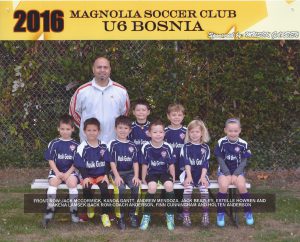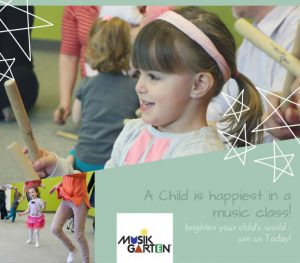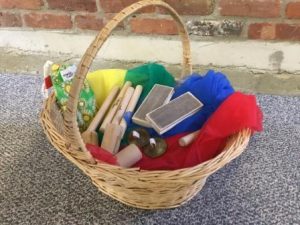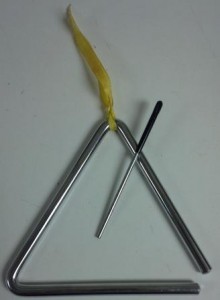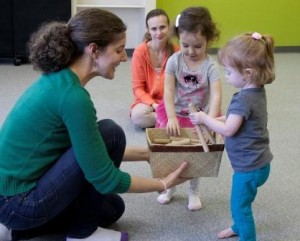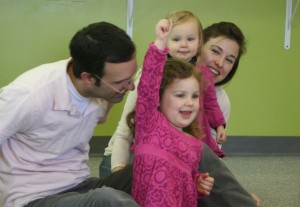Marketing your Musikgarten classes can be a challenge and sometimes it gets difficult coming up with new, out of the box ideas to try. Sometimes the best person to talk to is another Musikgarten teacher and the Gartenloop is good place to start.
One teacher, Nancy Kubo was graciously willing to share some of her ideas on the forum and agreed to let us reprint a few of them. Here is Nancy in her own words.
I have had a long-running studio program in Seattle with Lorna’s curricula for 30 years now and have a steady enrollment of 170-200 students every year. I have seen the enrollment rise and fall with economic conditions, with the arrival of competitive programs, and with the ups and downs of the birth rate. And advertising methods certainly evolved over the years with the arrival of the Internet.
I’m doing less and less on the internet the last few years, except for presence in three different online parent publication directories. My toddler enrollment in recent years was cut in half due to competition with not only other music programs but also the vast array of activities now available to toddlers.
My current strategy is to imprint the “Musikgarten” name on every parent’s mind in Seattle, so that when they think of toddler activity, or specifically music classes, they think of Musikgarten, just like when you think of tissue you think of “Kleenex”.
Here are some strategies that have worked for me:
1. Yard signs – I use the ones the Musikgarten makes. I got brave and put out 24 signs all around my area of Seattle. I’m kind of shy about it and it’s taken me forever to figure out where they can go without being removed. But now I don’t care, even if they do get removed a week or two later, I got my two weeks of exposure of the name. It only says Musikgarten — I don’t add my phone, and I cut off the musikgarten.org part because I’d rather a parent just Google Musikgarten and my website will come up.
When asked where she puts the signs or if she worries about them getting removed Nancy responds:
OK, where do I put the yard signs: they have to go in dirt/grass. Can’t put at a library, they’ll remove it right away because they can’t support a for-profit business. I do put them at playground corners, even though I shouldn’t, and just hope they stay as long as possible. Also intersections, medians and little traffic circles, but if they are really manicured; I don’t, because some nearby resident probably maintains it. I look for more neglected, grown over spots, which tells me nobody cares too much. And usually I place at an intersection where drivers have to stop. If they get removed, they are gone. I do not and retrieve the yard signs.
2) Auction fundraisers – I donate a $200 certificate to about 40 schools every year. Probably less than one third actually get used, but 100s of parents (1000s?) saw my little display and brochure on the auction table when they passed by it at the auction. Each contribution probably costs me about $4 or $5 for the photo printout and brochure and postage.
When asked if the dollar amount of the certificate is more of a draw than a “free semester” or “four weeks of class”, Nancy responds:
The reason I make it a $200 certificate is the parent can jump in anytime during the year for Babies, Toddlers, or Cycles and I don’t expect people to start at the very beginning of a term. This is also a studio grower. The auction organizers want a “value” stated and those three different age groups are different price points for a full term. If they join half way, then it carries over into the next term. But I really don’t give too much attention to all that, of course I’m glad to get certificate redeemers because they usually become steady families. My main reason for doing the auctions is the exposure at the silent auction table. I actually searched on the internet for every private and public school, and preschool in Seattle. Then went to their website to see if they do an auction and asked for the procurement form. I now participate in over 40 auctions. I know $200 is a lot, but I want them to come for at least 12 weeks, to get the feel.
3) Sports – I almost forgot to mention sports! I am now a baseball and soccer sponsor! Ugh! If you can’t beat them, join them! So all summer a huge Musikgarten banner hung in two different fields for baseball. Now two banners will hang on two soccer fields and “Musikgarten” will be on one team’s jerseys.
These strategies are ones that my competitors would never do, and therefore really give me an edge over them. Well that’s my recent experience.
And guess what, the toddlers are back!
Out-of-the-box ideas do not work for everyone’s situation. For some areas the marketing tactic that works is heavy internet marketing through Google or Facebook and for other areas a more grass roots effort is a key component.
Do you have out-of-the-box marketing ideas? Share them on this blog or on Gartenloop.
For information on the Gartenloop contact Denise at event@musikgarten.org.






